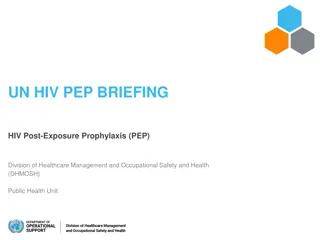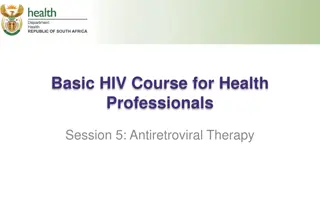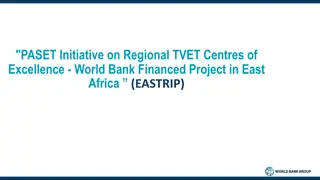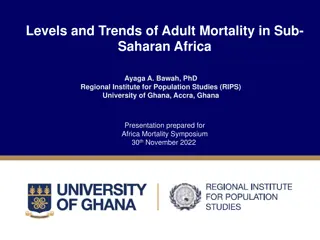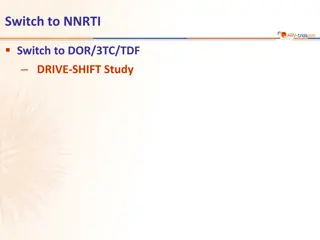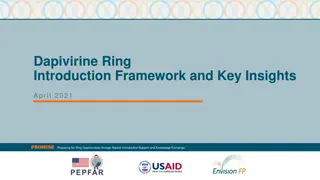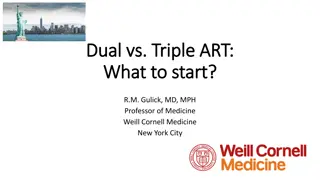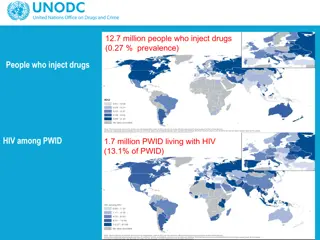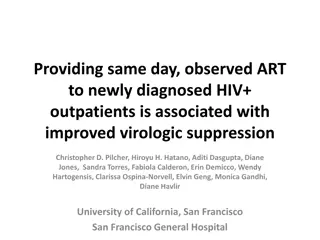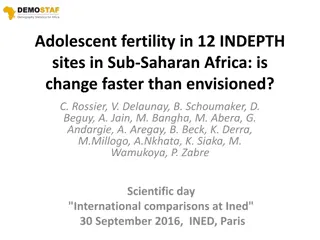Prior Exposure to Antiretroviral Therapy in Adult HIV Patients in Sub-Saharan Africa
A systematic review was conducted to assess the proportion of adult HIV patients in sub-Saharan Africa with prior antiretroviral therapy experience, specifically focusing on non-naive re-initiators. The study highlighted the challenges faced by these individuals and the need for tailored interventions to improve care continuity. Various criteria were used to analyze reports, including patient demographics, treatment initiation timings, and types of facilities providing services. The review aimed to gather empirical data on this population segment to inform better healthcare strategies for HIV treatment initiation and re-initiation in the region.
Download Presentation

Please find below an Image/Link to download the presentation.
The content on the website is provided AS IS for your information and personal use only. It may not be sold, licensed, or shared on other websites without obtaining consent from the author.If you encounter any issues during the download, it is possible that the publisher has removed the file from their server.
You are allowed to download the files provided on this website for personal or commercial use, subject to the condition that they are used lawfully. All files are the property of their respective owners.
The content on the website is provided AS IS for your information and personal use only. It may not be sold, licensed, or shared on other websites without obtaining consent from the author.
E N D
Presentation Transcript
Prior exposure to antiretroviral therapy among adult patients presenting for HIV treatment initiation or re-initiation in sub- Saharan Africa: A systematic review Mariet Benade, Mhairi Maskew, Allison Juntunen, Sydney Rosen Health Economics and Epidemiology Research Office (HE2RO), University of the Witwatersrand, Johannesburg, South Africa Department of Global Health, Boston University School of Public Health, Boston, MA, USA RETAIN6 11th SA AIDS Conference, 20-23 June 2023, Durban
Background and objectives Same-day/rapid ART initiation + high rates of disengagement from care have created a large and growing pool of individuals who present for initiation of treatment with prior ART experience ( non-na ve re-initiators ) By definition, non-na ve re-initiators previously were unable to overcome barriers to care and may face those same barriers again, without tailored interventions There are many estimates but few empirical data on the proportion of non-na ve re-initiators in various populations (A plenary speaker said, The vast majority of patients in South Africa are re-entering treatment. Do we know if it s really a majority? 60%? 80%) We conducted a rapid review of published reports with data on proportions of adult patients initiating ART who were treatment non-na ve in sub-Saharan Africa. RETAIN6
Methods Parameter Population Summary Adults initiating ART Inclusion criteria Ages 18; confirmed HIV positive; presenting for initiation of any regimen of lifelong ART Sub-Saharan Africa Reports primary, patient-level data from retrospective or prospective cohorts; any study design (trial, observational) with or without comparison group; systematic reviews, meta-analyses Describes all of patients, location, timing of ART initiation, facility type, service delivery models and services provided through public health facilities or NGO/private programs that serve the uninsured sector Exclusion criteria Ages <18; currently only receiving ART for HIV prevention (PrEP) None Case series or reports, purely qualitative studies, treatment guidelines, mathematical models, editorials, commentaries, protocols Geographic region Study design Africa Any with primary data Insufficient description of the characteristics needed to describe the study population and outcome Required descriptive data Basic description of population and services Reports proportion of patients initiating ART who are ART na ve and proportions of patients previously experienced on ART for any duration after initiation. Insufficient detail provided to estimate of outcome Outcomes % non-na ve at initiation A majority of data collected for ART initiation on or after January 1, 2016 A majority of data accrued before January 1, 2016 Timing Since 2016 RETAIN6
Methods Searched PubMed, EMBASE, Web of Science, IAS, CROI Primary outcome Proportion of adults presenting for ART initiation in public sector HIV programs in sSA who are not ART-na ve Evidence of prior ART use Self-reported Viral load suppression at ART initiation Medical record evidence Biological measurements of ART metabolites RETAIN6
+ 1 post-review RETAIN6
Results Years of ART initiation Indicator of prior exposure % non-na ve at initiation Country N Study design, source of data Study population (all enrolled adults only) 2016-2018 Not stated 7% Botswanaa 800 Baseline data for intervention arm of cluster randomized trial of HIV prevention HIV-positive during community HIV prevention campaign and linked to HIV care 2019-2021 Viral load suppressed at ART initiation 52% DR Congob 177 Observational prospective cohort of patients receiving dolutegravir Presenting for ART initiation or ongoing ART treatment at all ART clinics in Busia 2017 Self-report 21% Ethiopiac 430 Observational, cross-sectional study of first line treatment failure Received at least 6 months of ART 2015-2016 Viral load suppressed at ART initiation Self-report 30% Kenyad 63 Observational prospective cohort Men who have sex with men (MSM) 2017-2018 8% Kenyae 477 Baseline data for intervention arm of clinical trial of same-day ART initiation Presenting for ART initiation at 3 public sector hospitals 2021-2022 Viral load suppressed at ART initiation 27% Zambiaf 248 Baseline data for study of recent HIV infection Presenting for ART initiation at 2 public sector clinics 2017-2018 Self-report 2% South Africae (Gauteng) 600 Baseline data for intervention arm of clinical trial of same-day ART initiation Presenting for ART initiation at 3 public sector clinics 2016-2017 Self-report 5% South Africag (KZN) 390 Baseline data for randomized controlled trial of POC HIV viral load testing Clinically stable on ART and due for 6-month viral load testing 2018 Self-report 11% South Africah (Gauteng) 296 Baseline data for intervention arm in clinical trial of same-day ART initiation Presenting for ART initiation at 3 public sector clinics 2018 Viral load undetectable at ART initiation 32% South Africai (KZN) 193 Subset of baseline data from clinical trial of home-based ART initiation Non-pregnant, self-reported na ve, presenting for ART initiation at 2 public sector clinics, with CD4 >100 and no active TB 2017-2019 Presence of TDF, EFV, and/or FTC metabolites in blood and/or hair 53% South Africaj (Limpopo) 77 Baseline samples from clinical trial of drug resistance Self-reported na ve, presenting for ART initiation at 3 public sector clinics
Strengths and limitations Strengths Comprehensive review using multiple databases and conference abstract archives. Focused on recent data in the years since UTT adopted, increasing ART access (and thus disengagement and re-initiation) Recognized a wide range of reporting indicators for prior exposure to ARVs. Limitations Only used published reports (and in English) Most recent data not published yet (or not at all) Very constrained by the lack of standardized reporting of prior ARV exposure. RETAIN6
Summary of findings Proportion non-na ve differs widely, between studies and by method of defining Self-report 2-21% (5 studies) Viral suppression at ART initiation 27-52% (4 studies) Laboratory analysis of ARV metabolites 53% (1 study) There is a lack of published evidence on this question Only identified 10 studies in total, half of them in South Africa All small sample sizes; some excluded relevant sub-groups (e.g. self-reported non-na ve clients) Most report na ve vs non-na ve status incidentally as a cohort descriptor 80% of data earlier than 2020 probability of prior exposure must be increasing year on year Available indicators of prior exposure are problematic Self-report is unreliable Most clients don t receive viral load tests at initiation; viral suppression fades with time off ART Lack of unique identifiers limits use of medical record data (e.g. previous lab tests) Metabolite tests are expensive and only reflect immediately preceding period RETAIN6
How should we address this gap? Create standard definitions for re-initiation, prior exposure, etc. Start reporting the data we have (and asking about prior use if not already doing so) Link NHLS laboratory and Tier.Net clinic records to identify prior CD4 counts and viral load tests Conduct targeted studies of ARV metabolites for specific populations of interest Make self-report credible Improve our approach to service delivery among re-engagers so that clients are more willing to admit to prior exposure (Welcome Back )
References a. Lebelonyane R, Bachanas P, Block L, Ussery F, Abrams W, Roland M, et al. Rapid antiretroviral therapy initiation in the Botswana Combination Prevention Project: a quasi-experimental before and after study. Lancet HIV 2020;7: e545 e553. doi:10.1016/S2352-3018(20)30187-9 Buju RT, Akilimali PZ, Tran N-T, Kamangu EN, Mesia GK, Kayembe JMN, et al. Determinants of survival of HIV patients receiving dolutegravir: a prospective cohort study in conflict-affected Bunia, Democratic Republic of Congo. Int J Environ Res Public Health 2022;19. doi:10.3390/ijerph191610220 Genet A, Mekonnen Z, Yizengaw E, Mekonnen D. First line antiretroviral treatment failure and associated factors among people living with HIV in northwest Ethiopia. Afr Health Sci 2021;21: 263 272. Available: https://pubmed.ncbi.nlm.nih.gov/34394306/ Kunzweiler CP, Bailey RC, Mehta SD, Okall DO, Obondi E, Djomand G, et al. Factors associated with viral suppression among HIV-positive Kenyan gay and bisexual men who have sex with men. AIDS Care 2018;30: S76 S88. doi:10.1080/09540121.2018.1510109 Rosen S, Maskew M, Larson BA, Brennan AT, Tsikhutsu I, Fox MP, et al. Simplified clinical algorithm for identifying patients eligible for same-day HIV treatment initiation (SLATE): Results from an individually randomized trial in South Africa and Kenya. PLoS Med 2019;16: e1002912. doi:10.1371/journal.pmed.1002912 Dorward J, PK D, Osman F, Sookrajh Y, Pillay M, Moodley P, et al. Short communication: early antiretroviral therapy is associated with better viral suppression and less HIV drug resistance after implementation of universal treatment in South Africa. AIDS Res Hum Retroviruses 2020;36: 297 299. Available: https://pubmed.ncbi.nlm.nih.gov/31663368/ Pry J, Mwila C, Kapesa H, Mulabe M, Frimpong C, Savory T, Bolton Moore C, Herce ME, Iyer SS. Viral suppression at ART initiation in Zambia. CROI 2023, Seattle, Abstract 1052. Maskew M, Brennan AT, Fox MP, Vezi L, Venter WDF, Ehrenkranz P, et al. A clinical algorithm for same-day HIV treatment initiation in settings with high TB symptom prevalence in South Africa: The SLATE II individually randomized clinical trial. PLoS Med 17(8): e1003226. https://doi.org/10.1371/journal.pmed.1003226 Mavhandu-Ramarumo LG, Tambe LAM, Matume ND, Katerere D, Bessong PO. Undisclosed exposure to antiretrovirals prior to treatment initiation: An exploratory analysis. South Afr J HIV Med 2021;22: 1 10. doi:10.4102/sajhivmed.v22i1.1200 Sithole N, Gunda R, Koole O, Krows M, Schaafsma T, Moshabela M, et al. Undisclosed antiretroviral therapy use at primary health care clinics in rural KwaZulu Natal South Africa: A DO-ART trial sub-study. AIDS Behav 2021. doi:10.1007/s10461-021-03319-4 b. c. d. e. f. g. h. i. j. Full review available at https://www.medrxiv.org/content/10.1101/2022.10.19.22281280v1 Summary available at https://www.aidsmap.com/news/may-2023/many-half-people-starting-hiv- treatment-africa-have-taken-it RETAIN6
Thank you! Support for Retain6 was provided by the Bill & Melinda Gates Foundation RETAIN6




